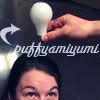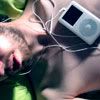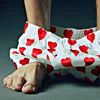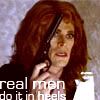Ask Puffy!
I've narrowed down a queue of Photoshop-realted questions to two. These little How-Tos, however, assume that you know how to use Photoshop well enough to know where things are and what most things do. Any other questions? Just ask. Let's take a gander:
Dear Puffy, how do people superimpose other people into pictures?
Combining two pictures well and with convincing results can be extremely difficult. And with some corners you can cut, you don't have to be a Photoshop genius to do it. Let's begin:
Step One: Selecting the right images.
The easiest pictures to combine are ones taken with flash- because the light is straight-on and uniform. Keep LIGHT in mind. If the light is coming from the right in one and from the left in the other, no matter what you do the end result will look faked. Another thing to consider is IMAGE QUALITY. I defenestrated this rule for the sake of a quick example, but if one is a low-quality JPEG while the other came from your digital camera, it's better not to combine the two. And the final thing to consider is CONTEXT. If you're combining two people, make sure the context of the facial expression, clothing, stance, and other important factors in the context of the image jive. Following the LIGHT and CONTEXT rules (Yes, I made up these rules), I chose two images:


The light is uniform, the stances and facial expressions jive, and my plan is to place Tory in my arm, replacing Jaime. The main problem is the graininess of the picture of Tory and the poor image quality. The color and brightness can be altered in Photoshop.
Step Two. Size 'em up.
Of course, the main discrepancy among the images is size. Tory is about 500 pixels tall, while Jaime is around 1000 or so. This is the most difficult (and most important) step. I get the general idea of size difference by cropping out everything but Jaime and Tory's faces, and shrink the image of Jaime and me to the right size where Tory looks naturally proportioned next to me. Never expand an image! Just keep decreasing the image size of the larger image until you get it right.
Step Three. Cut it out.
Now that Tory is the same size as me, a decision needs to be made. Will I put Tory in my image, or me in Tory's image? It seems silly for me to be in Tory's setting, and it would be more difficult to pull that off. Also, it is painfully easy to pull Tory from his image, while I'm intertwined and against a complex background, making selecting myself very difficult. Using the magnetic lasso tool, select the image you wish to place in the background image.

I got sloppy at the bottom because it won't be shown. Now copy the selection and paste into the background image- it will automatically create a new layer. Now position the new layer into a natural-looking place.
Step Four. Layer the bodies.
Right now, Tory's bust is obviously pasted in and where my arm showed up around Jaime is now covered by the new layer. To compensate for this, use the magnetic lasso to select parts that need to appear "above" the superimposed image. In the case of my example- my face and left arm. After selecting those with the magnetic lasso, copy and pasting should automatically position the layer, so simply place it above the layer of the superimposed image.

That's actually two layers. And those combined with Tory (post editing, pardon my lack of proper contingency) looks like this:

Step Five. Make it work.
Now your image should look somewhat realistic except for rough edges, color, lighting, and a distinct lack of shadows. This should take a while and you'll probably never be satisfied, but here are some things to consider:
1. Color. Tory was more on the red size, while I was more on the yellow side. Alter the superimposed layer's color through Selective Color. If there is a lack of color in one of the images, mess with saturation in Hue/Saturation.
2. Brightness. Tory was slightly darker and had more contrast, so I brightened up his layer and took some edge off by lowering contrast.
3. Rough edges. With a small eraser with 100% hardness, remove edges from the superimposed layer(s- my arm and head too) very carefully pixel by pixel.
4. Shadows/Lighting. Since my face is now pressed against Tory's, I need to add shadows to his face and shirt. Using the Burn tool, I carefully do some manual shading. This gives the superimposed image depth and don't any shadows you add need to be added to the original image too.
5. Background. Hopefully your choice in images and sizing kept you from having the background showing. If so, clone out any sign of it or you may have to reconsider the position of the superimposed image.
Keep tweaking until you're satisfied. Improvise with any other problems you run into.
Step Six. Fake it.
Despite all my manual shading and careful deleting, Tory still looks like a leper next to my smooth, high quality face because I chose a bad image. In order to fake it, I use the blur tool to smooth out his skin, flatten the image and desaturate make it monochrome and eliminating any color discrepancies. Finally, I had to use a grain filter make the whole image grainy. This tactic works nicely when all else fails. I once saw a picture of Dominic Monaghan and Elijah Wood making out, but the image was so dark and blurry that you really have to give it the benefit of the doubt. Mark up any changes as "artistic freedom".
The final image turned out like this:

I know it doesn't look too realistic, but I did it in an hour. Lay off.

Just to show what else you can do.
How do I get the cool color effects on my LiveJournal icons?
Simple. Once you have your icon, create a new layer. Now fill it with a LIGHT color. For a deep blue effect, use a pale blue. Seriously. Even that might be too much. Try as many colors as you want.
Using the Blending options, select Color Burn and voilà. You may have to adjust the sliders a bit to take the edge off, but it's as easy as that. Here are a few examples:


Blue.

Sea Green.

Lime Green.

This is actually a gradient going from pink to yellow. Yes- you can do gradients too. Here's another one:

I hope that answers your questions.
Dear Puffy, how do people superimpose other people into pictures?
Combining two pictures well and with convincing results can be extremely difficult. And with some corners you can cut, you don't have to be a Photoshop genius to do it. Let's begin:
Step One: Selecting the right images.
The easiest pictures to combine are ones taken with flash- because the light is straight-on and uniform. Keep LIGHT in mind. If the light is coming from the right in one and from the left in the other, no matter what you do the end result will look faked. Another thing to consider is IMAGE QUALITY. I defenestrated this rule for the sake of a quick example, but if one is a low-quality JPEG while the other came from your digital camera, it's better not to combine the two. And the final thing to consider is CONTEXT. If you're combining two people, make sure the context of the facial expression, clothing, stance, and other important factors in the context of the image jive. Following the LIGHT and CONTEXT rules (Yes, I made up these rules), I chose two images:


The light is uniform, the stances and facial expressions jive, and my plan is to place Tory in my arm, replacing Jaime. The main problem is the graininess of the picture of Tory and the poor image quality. The color and brightness can be altered in Photoshop.
Step Two. Size 'em up.
Of course, the main discrepancy among the images is size. Tory is about 500 pixels tall, while Jaime is around 1000 or so. This is the most difficult (and most important) step. I get the general idea of size difference by cropping out everything but Jaime and Tory's faces, and shrink the image of Jaime and me to the right size where Tory looks naturally proportioned next to me. Never expand an image! Just keep decreasing the image size of the larger image until you get it right.
Step Three. Cut it out.
Now that Tory is the same size as me, a decision needs to be made. Will I put Tory in my image, or me in Tory's image? It seems silly for me to be in Tory's setting, and it would be more difficult to pull that off. Also, it is painfully easy to pull Tory from his image, while I'm intertwined and against a complex background, making selecting myself very difficult. Using the magnetic lasso tool, select the image you wish to place in the background image.

I got sloppy at the bottom because it won't be shown. Now copy the selection and paste into the background image- it will automatically create a new layer. Now position the new layer into a natural-looking place.
Step Four. Layer the bodies.
Right now, Tory's bust is obviously pasted in and where my arm showed up around Jaime is now covered by the new layer. To compensate for this, use the magnetic lasso to select parts that need to appear "above" the superimposed image. In the case of my example- my face and left arm. After selecting those with the magnetic lasso, copy and pasting should automatically position the layer, so simply place it above the layer of the superimposed image.

That's actually two layers. And those combined with Tory (post editing, pardon my lack of proper contingency) looks like this:

Step Five. Make it work.
Now your image should look somewhat realistic except for rough edges, color, lighting, and a distinct lack of shadows. This should take a while and you'll probably never be satisfied, but here are some things to consider:
1. Color. Tory was more on the red size, while I was more on the yellow side. Alter the superimposed layer's color through Selective Color. If there is a lack of color in one of the images, mess with saturation in Hue/Saturation.
2. Brightness. Tory was slightly darker and had more contrast, so I brightened up his layer and took some edge off by lowering contrast.
3. Rough edges. With a small eraser with 100% hardness, remove edges from the superimposed layer(s- my arm and head too) very carefully pixel by pixel.
4. Shadows/Lighting. Since my face is now pressed against Tory's, I need to add shadows to his face and shirt. Using the Burn tool, I carefully do some manual shading. This gives the superimposed image depth and don't any shadows you add need to be added to the original image too.
5. Background. Hopefully your choice in images and sizing kept you from having the background showing. If so, clone out any sign of it or you may have to reconsider the position of the superimposed image.
Keep tweaking until you're satisfied. Improvise with any other problems you run into.
Step Six. Fake it.
Despite all my manual shading and careful deleting, Tory still looks like a leper next to my smooth, high quality face because I chose a bad image. In order to fake it, I use the blur tool to smooth out his skin, flatten the image and desaturate make it monochrome and eliminating any color discrepancies. Finally, I had to use a grain filter make the whole image grainy. This tactic works nicely when all else fails. I once saw a picture of Dominic Monaghan and Elijah Wood making out, but the image was so dark and blurry that you really have to give it the benefit of the doubt. Mark up any changes as "artistic freedom".
The final image turned out like this:

I know it doesn't look too realistic, but I did it in an hour. Lay off.

Just to show what else you can do.
How do I get the cool color effects on my LiveJournal icons?
Simple. Once you have your icon, create a new layer. Now fill it with a LIGHT color. For a deep blue effect, use a pale blue. Seriously. Even that might be too much. Try as many colors as you want.
Using the Blending options, select Color Burn and voilà. You may have to adjust the sliders a bit to take the edge off, but it's as easy as that. Here are a few examples:


Blue.

Sea Green.

Lime Green.

This is actually a gradient going from pink to yellow. Yes- you can do gradients too. Here's another one:

I hope that answers your questions.